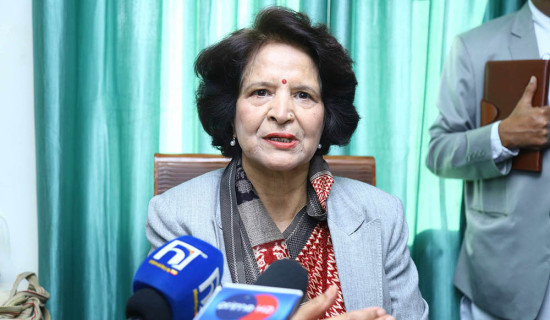- Friday, 26 December 2025
Physical Activity Maintains Health
Regular physical activity is one of the most important ways to improve health and wellbeing. Moderate level of physical activity has been shown to improve brain health, strengthen bones and muscles, help maintain weight and reduce the risk of many non-communicable diseases. It has been proven that many of the non-communicable diseases such as hypertension, stroke, heart diseases and numerous cancers can greatly be reduced with physical activity. However, there is less awareness among the general population on how damaging and expensive reduced physical activity can be.
Globally, an estimated one in four adults and around 81 per cent adolescents do not meet prescribed amount of physical activity (WHO, 2022). A study in Nepal showed that about 8 per cent males and 31 per cent females had low physical activity. The same study showed that about 31 per cent of the adolescents and 14 per cent of young adults did not meet the WHO recommendations of physical activity (Thapa et al 2019).
Brain performance
There are both immediate and long-term benefits of physical activity. Immediate benefits include improved thinking or cognition for children aged between 6 and 13 years and reduced short-term feelings of anxiety for adults (CDC, 2022). Regular physical activity improves all aspects of brain performance such as thinking, learning and judgment skills among all age group. It helps in reducing the risk of depression and anxiety as well as improves sleeping pattern. Besides eating habits, physical activity plays a critical role in weight management. It has been recommended to carry out moderate level of physical activity at least 150 minutes per week. This goal can be achieved by carrying out with as little as 30 minutes of activity every day.
Heart disease and stroke are two leading causes of deaths worldwide. The recommended level of moderate activity has shown significant reduction in both the conditions and more activities even decrease the prevalence further. Physical activity helps in reducing blood pressure and blood cholesterol level.
Physical inactivity is associated with insulin resistance responsible for the development of Type 2 diabetes. Metabolic syndrome is associated with abdominal obesity, high blood pressure, low high-density lipoproteins (HDL) cholesterol, high triglycerides, and high blood sugar. Therefore, moderate level physical activity greatly reduces chances of Type 2 diabetes and it also helps maintain blood sugar level in patients with Type 2 diabetes. People who perform moderate level of physical activity may have reduced chances of many of cancers such as breast, bladder, stomach, lung, colon and kidney, etc. It also helps in improving physical fitness, wellbeing and quality of life among cancer survivors.
Increased sedentary behaviour and spending more time sitting in chairs with computers is destined to be associated with increased risks for weight gain, heart disease, Type 2 diabetes, and premature death, to name a few. It has been reported that the effects of lower physical activity start shortly within as early as three-four weeks. Obesity and physical activity are interlinked. The risk of obesity is four times higher among physically inactive individuals.
As our population is rapidly aging, physical activity helps improve physical function as well as decrease the risks of falls and injuries among elderly population. It is important to protect bones, joints and muscles particularly among old adults in order to be able to perform daily activities and be physically active. Muscle strengthening activities are particularly useful for older adults as muscle mass and strength are reduced with aging.
An ideal 10,000 steps a day has been shown to decrease premature deaths from all causes among people of age 40 and higher. The people who are insufficiently active have 20-30 per cent increased risk of deaths compared to physically fit people (WHO, 2018). There is no strong evidence that we need to strive for 10,000 steps a day. The concept of those numbers of steps originated from Japan in the 1960s as a marketing campaign. However, if it is possible for anyone to achieve the goal, it is better to strive for.
Awareness
There are different intensities for physical activity as low, medium and high. Low-intensity activities include slow and leisurely walk, light household chores, medium intensity activity include brisk walking, and playing doubles tennis and high-intensity activity includes jogging, running, and rigorous aerobics, etc. There have been growing concerns about sedentary behaviour which burns very low level of energy such as sitting, lying or television viewing and its health impact. Studies had shown a strong relationship between increased health risks and an increase in sedentary behaviour.
The World Health Organisation (2018) has recommended physical activity for the different age group. It suggests at least 60 minutes of moderate to vigorous physical activity for 5-17 years old adolescents three times a week. Similarly, for adults aged 18-64, it recommends either 150 minutes of moderate intensity physical activity in a week or 75 minutes of high-intensity physical activity or an equivalent combination of moderate and high-intensity physical activity. For older people aged more than 65 years of age, WHO recommends the same amount of physical activity as for aged 18-64 years old.
The awareness about the benefits of physical activity and advice to maintain physical activity is dangerously low among people of all age groups. It has been warned that physical activity is grossly insufficient among all age groups and responsible for millions of deaths every year. It is, therefore, urged to all stakeholders including both the governmental and non-governmental organisations to collaborate to promote the physical activity among all age groups throughout the country.
(Dr. Lohani is the clinical director at the Nepal Drug and Poison Information Centre. lohanis@gmail.com)














-original-thumb.jpg)

